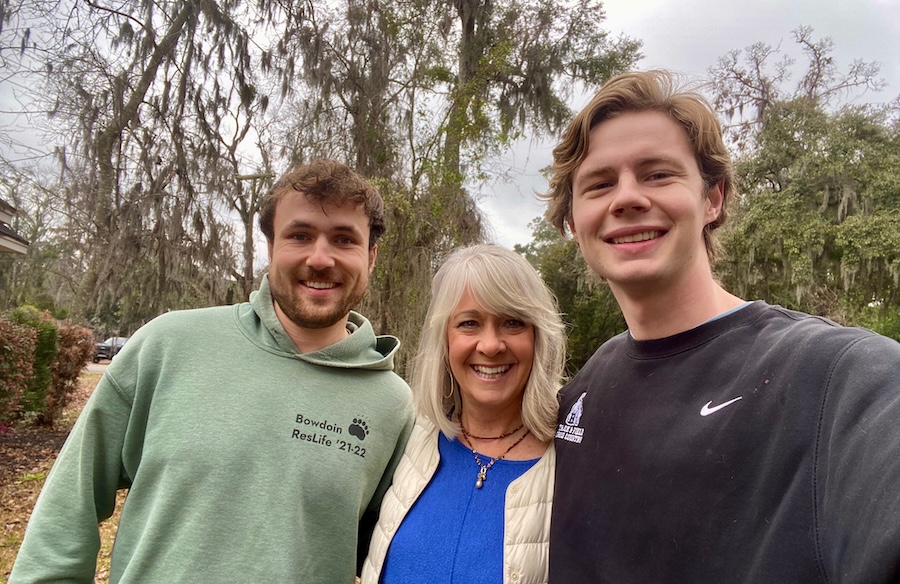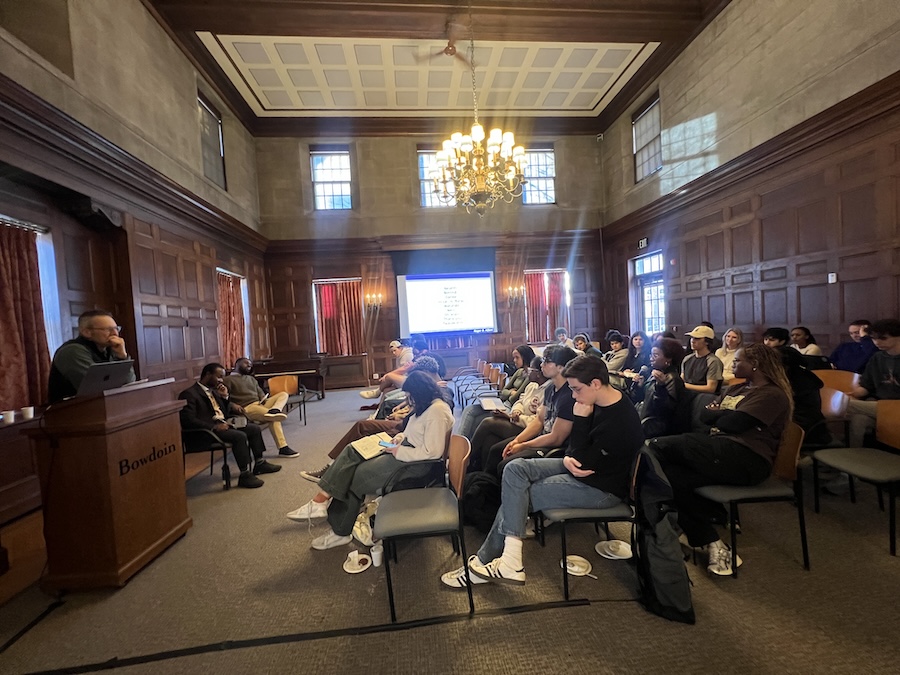Michael Lettieri ’05: 'Making Sense of Mexico's Murdered and Missing'
By Rebecca Goldfine
Michael Lettieri ’05 recently visited Bowdoin to discuss the unsolved disappearance in 2014 of 43 young Mexican men, all college students from poor backgrounds who had been studying to become teachers in rural schools.
Lettieri, who has a Ph.D. from the University of California, San Diego, is a historian of Mexico who works for the Trans-Border Institute at the University of San Diego. Although the details of the missing 43 young men remain murky, Bowdoin Professor of History Allen Wells said he had invited Lettieri, his former student, to Bowdoin to shed light on the massacre and to place it in political and social contexts.
Lettieri quickly made the point that the 43 students were not unique, that “theirs was not a singular episode.” Instead, their murders fit into a “horrifying spiral of violence” in Mexico that has, over the past decade, spread throughout the country, including to previously peaceful areas. Lettieri noted that the rising violence can’t be simply explained as the result of “a drug war” between well-established, powerful cartels. “The violence in Mexico is not a monolithic phenomenon caused by struggles between or against cartels,” he explained. “The causes are not as clearly tied to the international narcotics trade as is often believed.”
Aggravating Circumstances
Several factors have helped inflame the violence. First, the expiration of the U.S. ban on assault weapons in 2004 has given “gangsters in Mexico” a “new source of impressive firepower,” according to Lettieri. A study by the U.S. Bureau of Alcohol, Tobacco, Firearms, and Explosives found that more than 73 percent of guns confiscated in Mexico in 2007 came from the U.S., and another report from the Justice in Mexico Project concluded that more than 200,000 weapons were smuggled across the border between 2010 and 2012.
Also abetting the rise of criminality has been a shift in political power. For more than 70 years, Mexico was a one-party state, ruled by the Institutional Revolutionary Party, or PRI. The PRI was closely tied to drug trafficking, and this involvement helped keep levels of violence in check. When the country transitioned to a democracy in 2000, weakening political control may have led to greater lawlessness. “Cartel-like activity [has spread] across the country’s criminal landscape,” Lettieri said.
Another factor is that murderers, kidnappers, and corrupt officials are rarely imprisoned in Mexico. The country’s rate of solving homicide cases is just 2 percent.
While Lettieri explored both the historical roots and contemporary causes of violence in Mexico, he ended his lecture on what he believes may help the country attain peace and justice.
The Case of the Missing 43
The case of the 43 missing — presumably murdered – college students from Guerrero captured the world’s attention. To underscore his argument that the violence in Mexico is diverse and widespread, Lettieri also described two other haunting cases of disappearances: a busload of passengers in San Fernando, in 2011, and five teenagers returning from a weekend at the beach in Veracruz, who vanished this January. The violence is linked to not just large drug cartels, but also to smaller drug gangs and other criminals. Police and government officials at all levels are often complicit. Innocent people are frequently targeted.
Lettieri’s visit to Bowdoin coincided with the release of a report by an international panel of human rights experts who had been invited to Mexico to investigate the case in Guerrero. They were, ultimately, unsuccessful in uncovering what happened to the young men, reporting that they had been obstructed in their mission to find the truth by the Mexican government and state-run media.
On the night they went missing — Sept. 26, 2014 — a group of students were on their way from Ayotzinapa, Guerrero, to Mexico City to join a march commemorating the Tlatelolco student massacre of 1968. To reach their destination, the students had “commandeered” buses, a regular practice of Mexican university students. While bus companies and police find this behavior irksome, it is mostly tolerated as a kind of youthful prank. Bus companies instruct drivers to stay with their buses, and eventually students do return both vehicles and drivers unharmed. “The violence [the students] would encounter that night would therefore come as a shock,” Lettieri said, “most of all to the principally first-year students for whom the activity was their initiation into the college’s traditions.”
The students ended up commandeering five buses. What followed was a confusing and deadly confrontation with police in the city of Iguala. The fate of one student is known. Julio César Mondragón Fontes, 22, was found the morning after the kidnapping, the skin on his face, ears and nose cut off and his eyes gouged out. Forty-three other students have never been seen or heard from again.
The official investigation, later criticized for being mishandled, found that the municipal police had turned the students over to members of a drug cartel who killed them and burned their bodies in a local dump. “The official investigation focused on the mayor of Iguala and his politically ambitious wife, who had close ties to the Guerreros Unidos cartel, and had apparently turned the municipal police force into an arm of the cartel,” Lettieri said. Explanations offered for the attack included a misidentification of the students as members of a rival cartel, or an attempt to divert them from protesting at a political event organized by the mayor’s wife. Neither of these theories has withstood any amount of scrutiny, according to Lettieri.
The team of international investigators has suggested the attack might have been intended to prevent the students from taking a bus, or buses, that contained drug money or drugs, perhaps heroin destined for the United States. The role of police and politicians in the massacre has also become evident. “Little effort was made to disguise the participation of municipal police officers,” Lettieri said, who likely acted at the behest of the mayor, who was a cartel operative. State police and federal military personnel at the scene refused to provide assistance or intervene.
Lettieri said this case highlights recent trends in Mexican violence. While it is likely connected to drug activity, the criminal groups operating in the state of Guerrero are less centralized and less organized than larger cartels. “Guerreros Unidos, the cartel connected to the disappearance, resembles a localized gang more than a well-organized transnational trafficking organization,” Lettieri said.
The End of Violence
How to end the violence in Mexico is “the million-dollar question,” Lettieri said. “Or the $2.5 billion question, if we are measuring in money all that the U.S. government has channeled to fighting the drug war in Mexico through the Mérida Initiative.”
One proposal, to legalize drugs in the United States, is not a quick fix. Indeed, “It is actually likely to increase violence in Mexico in the short-term as cartels struggle over decreasing revenue streams and diversify into new criminal activities,” Lettieri said.
What needs to happen, Lettieri argued, and what some Mexicans are trying to bring about, is the creation of a grassroots movement that can defuse the culture of violence. Narcos glorify violence, according to Lettieri. Children are being raised and desensitized in environments of extreme violence. Yet, journalists and civil society organizations are also “giving voice to the pain of those who have suffered,” he said. Instead of focusing on gory images, a few reporters are writing about the pain of victims and survivors, exposing the failure and corruption of the state, and creating an accurate record of what is happening.
Lettieri said he is hopeful that this kind of activity can help bring an end to the bloodbath. “Mexico is a paradox,” he continued. “At the same time as you have all this violence, the country is a top tourist destination. It has regular democratic elections. It’s the third most important trading partner for the U.S. It has a lot of violence but also a lot of potential in its civil society. There is a resolution to this violence, but we just haven’t found it yet.”



